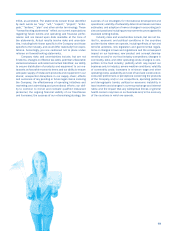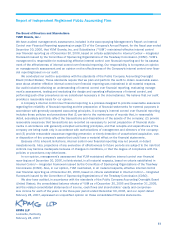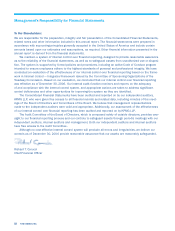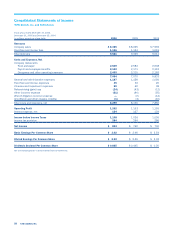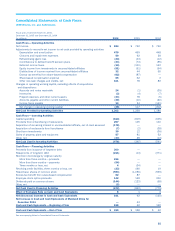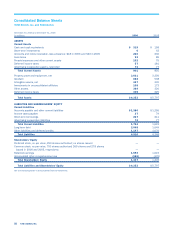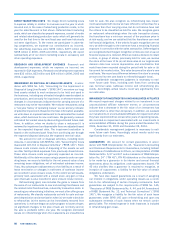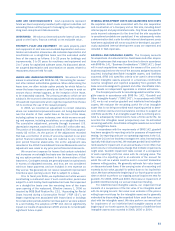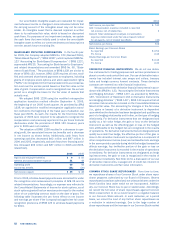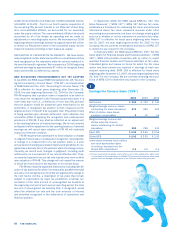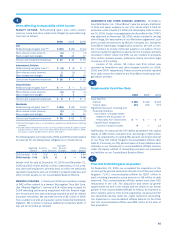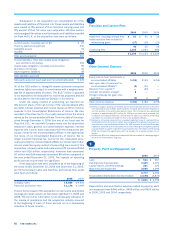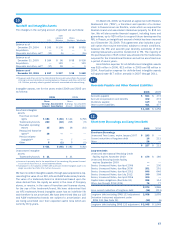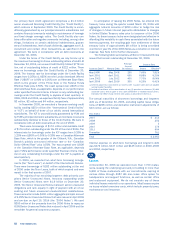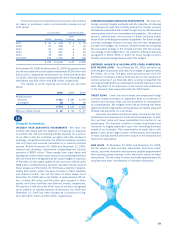Pizza Hut 2006 Annual Report Download - page 54
Download and view the complete annual report
Please find page 54 of the 2006 Pizza Hut annual report below. You can navigate through the pages in the report by either clicking on the pages listed below, or by using the keyword search tool below to find specific information within the annual report.
59
the Consolidated Balance Sheet. The advertising cooperatives
assets, consisting primarily of cash received from franchisees
and accounts receivable from franchisees, can only be used for
selected purposes and are considered restricted. The advertising
cooperative liabilities represent the corresponding obligation aris-
ing from the receipt of the contributions to purchase advertising
and promotional programs. As the contributions to these coop-
eratives are designated and segregated for advertising, we act as
an agent for the franchisees and licensees with regard to these
contributions. Thus, in accordance with Statement of Financial
Accounting Standards (“SFAS”) No. 45, “Accounting for Franchise
Fee Revenue,” we do not reflect franchisee and licensee contribu-
tions to these cooperatives in our Consolidated Statements of
Income or Consolidated Statements of Cash Flows.
In 2004, we adopted Financial Accounting Standards Board
(“FASB”) Interpretation No. 46 (revised December 2003), “Con-
solidation of Variable Interest Entities, an interpretation of ARB
No. 51” (“FIN 46R”). FIN 46R addresses the consolidation of an
entity whose equity holders either (a) have not provided sufficient
equity at risk to allow the entity to finance its own activities or (b)
do not possess certain characteristics of a controlling financial
interest. FIN 46R requires the consolidation of such an entity,
known as a variable interest entity (“VIE”), by the primary ben-
eficiary of the entity. The primary beneficiary is the entity, if any,
that is obligated to absorb a majority of the risk of loss from the
VIE’s activities, entitled to receive a majority of the VIE’s residual
returns, or both. FIN 46R excludes from its scope businesses (as
defined by FIN 46R) unless certain conditions exist.
The principal entities in which we possess a variable interest
include franchise entities, including our unconsolidated affiliates
described above. We do not possess any ownership interests in
franchise entities except for our investments in various uncon-
solidated affiliates accounted for under the equity method.
Additionally, we generally do not provide financial support to
franchise entities in a typical franchise relationship.
We also possess variable interests in certain purchasing
cooperatives we have formed along with representatives of the
franchisee groups of each of our Concepts. These purchasing
cooperatives were formed for the purpose of purchasing cer-
tain restaurant products and equipment in the U.S. Our equity
ownership in each cooperative is generally proportional to our
percentage ownership of the U.S. system units for the Concept.
We account for our investments in these purchasing cooperatives
using the cost method, under which our recorded balances were
not significant at December 30, 2006 or December 31, 2005.
As a result of the adoption of FIN 46R, we have not con-
solidated any franchise entities, purchasing cooperatives or
other entities.
FISCAL YEAR Our fiscal year ends on the last Saturday in
December and, as a result, a 53rd week is added every five or
six years. Fiscal year 2005 included 53 weeks. The first three
quarters of each fiscal year consist of 12 weeks and the fourth
quarter consists of 16 weeks in fiscal years with 52 weeks and
17 weeks in fiscal years with 53 weeks. In fiscal year 2005, the
53rd week added $96 million to total revenues and $23 million
to total operating profit in our Consolidated Statement of Income.
Our subsidiaries operate on similar fiscal calendars with period
or month end dates suited to their businesses. The subsidiaries’
period end dates are within one week of YUM’s period end date
with the exception of all of our international businesses except
China. The international businesses except China close one
period or one month earlier to facilitate consolidated reporting.
RECLASSIFICATIONS We have reclassified certain items in the
accompanying Consolidated Financial Statements and Notes
thereto for prior periods to be comparable with the classification
for the fiscal year ended December 30, 2006. These reclassifica-
tions had no effect on previously reported net income.
The most significant reclassification we made was related to
the presentation of deferred taxes on our Consolidated Balance
Sheet at December 31, 2005. Previously, deferred tax assets
and liabilities were netted for all tax jurisdictions outside of the
U.S. Due to the implementation of new tax accounting software,
we netted our deferred tax assets and liabilities at the individual
tax jurisdiction level outside the U.S. at December 30, 2006. We
reclassified certain amounts on our Consolidated Balance Sheet
at December 31, 2005 to be consistent with this presentation
which resulted in an increase to both current deferred income tax
assets and liabilities of $18 million and an increase to both long
term deferred income tax assets and liabilities of $87 million.
FRANCHISE AND LICENSE OPERATIONS We execute franchise
or license agreements for each unit which set out the terms of our
arrangement with the franchisee or licensee. Our franchise and
license agreements typically require the franchisee or licensee to
pay an initial, non-refundable fee and continuing fees based upon
a percentage of sales. Subject to our approval and their payment
of a renewal fee, a franchisee may generally renew the franchise
agreement upon its expiration.
We incur expenses that benefit both our franchise and
license communities and their representative organizations and
our Company operated restaurants. These expenses, along with
other costs of servicing of franchise and license agreements
are charged to general and administrative (“G&A”) expenses as
incurred. Certain direct costs of our franchise and license opera-
tions are charged to franchise and license expenses. These costs
include provisions for estimated uncollectible fees, franchise and
license marketing funding, amortization expense for franchise
related intangible assets and certain other direct incremental
franchise and license support costs.
We monitor the financial condition of our franchisees and
licensees and record provisions for estimated losses on receiv-
ables when we believe that our franchisees or licensees are unable
to make their required payments. While we use the best informa-
tion available in making our determination, the ultimate recovery
of recorded receivables is also dependent upon future economic
events and other conditions that may be beyond our control. Net
provisions for uncollectible franchise and license receivables of
$2 million, $3 million and $1 million were included in franchise
and license expense in 2006, 2005 and 2004, respectively.
REVENUE RECOGNITION Our revenues consist of sales by Com-
pany operated restaurants and fees from our franchisees and
licensees. Revenues from Company operated restaurants are
recognized when payment is tendered at the time of sale. We
recognize initial fees received from a franchisee or licensee as
revenue when we have performed substantially all initial services
required by the franchise or license agreement, which is gener-
ally upon the opening of a store. We recognize continuing fees
based upon a percentage of franchisee and licensee sales as
earned. We recognize renewal fees when a renewal agreement
with a franchisee or licensee becomes effective. We include initial
fees collected upon the sale of a restaurant to a franchisee in
refranchising (gain) loss.


